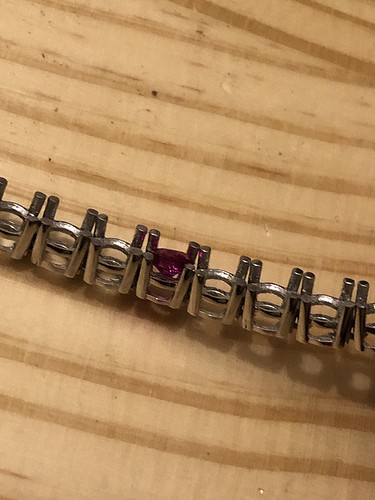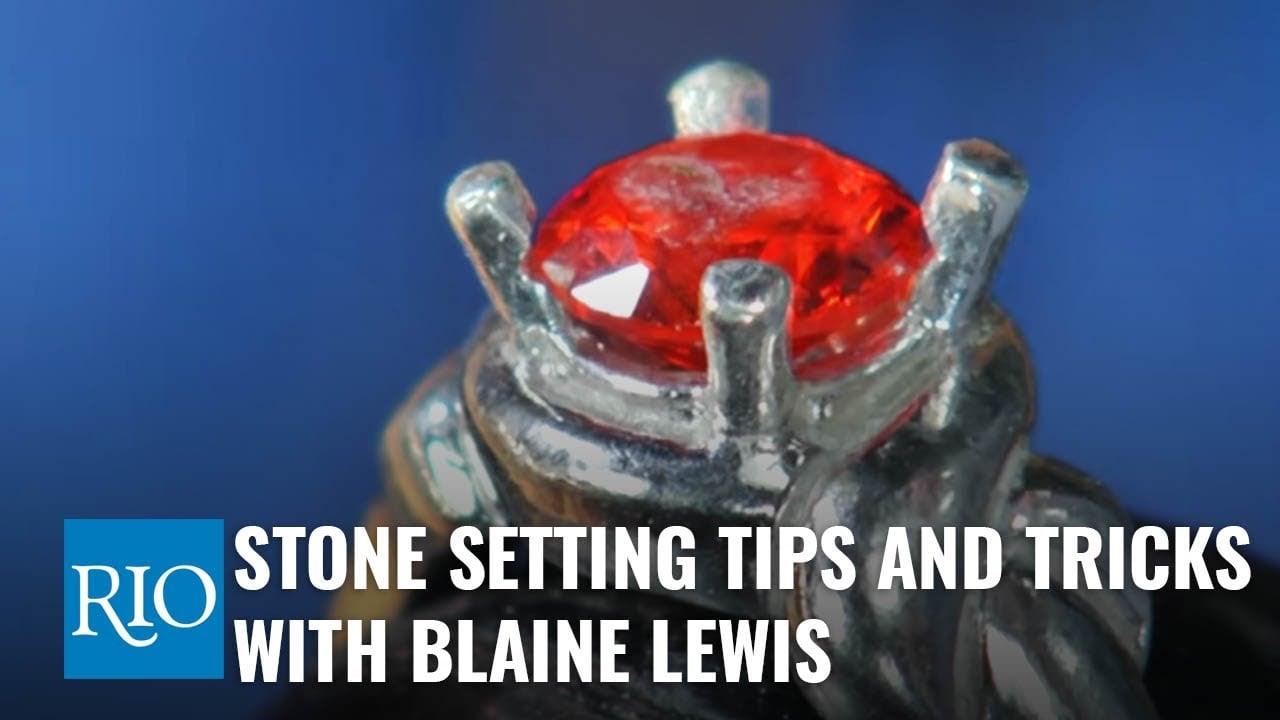Okay hear me out guys.
I recently purchased two tennis bracelet mounts for a 5x5 round stone, it was from india, so it took awhile to arrive. I don’t have the skills to make this at all, but I have a two cool idea’s for color scheme’s . I was planning on buying an assortment of flame fusion corundum/spinel and natural 5x5 round stones in bulk because it would also benefit my recent project that uses the same type. So cool, I’m ready to place the order for the stones, but I wanted to test the size first. I go to check it, and the outside diameter is somewhere around 5.15mm, but the prongs are too large so I couldn’t even fit a 4.75mm stone.
So I was just wondering if you guys think the prongs would be strong enough if I just used a ball bur of similar size and just run it down the center of the prongs to create a setting for the stones. Maybe that’s what I’m supposed to do anyway, but I learn by trial an error for now so I just wanted someone’s opinion before I waste money on buying stones.
Thanks 
I am not certain exactly what you are asking, but I will try.
I am unfamiliar with “5x5 round”, as round gemstones are generally referred to be diameter, say “5mm round”, which I am assuming you may mean.
Unless you are purchasing jewelry precut for fast setting, you will need to cut a “seat” for placing your stones into the settings, and then work the prongs onto the crown facets.
There are lighter, prepared setting with seats already stamped into the jewelry, to fit one calibrated size, but they are mostly intended for the mass market, where everything is about bulk, speed and low $.
1 Like
A photo of the setting might help, at least that way we can see what you’re starting with.
1 Like
As you can see it can’t fit straight down so it goes sideways.
This is exactly how a stone should fit on a setting before the seat is prepared to fit.
This allows you to use a burr the cut a seat to both the correct diameter of your stone, and the correct depth. Stones have different thickness of gridles, and crown heighths, so you cut your seats individually to the diameter and depth you need for each stone, so that you have suffient and even looking prongs to hold, and so the stones appear to all match.
2 Likes
Hahaha leave it up to a noob. Should’ve just stuck with the gut to begin with.
1 Like
Look, I’ve been learning in pandemic isolation- you don’t know what you don’t know until you take the leap!
1 Like
I am not mocking. We all have to start from scratch at some point, and we do not know what we do not know, until we know a bit more.
After 45+ years at the bench I am still learning.
What I was trying to say, and I may not have said it well, is that a correct fit of a genstone ( this is general, not always how it goes), when you set a gemstone on top of a setting that is correct for it, it should be larger than the inside circumference of the space between those prongs, sitting on top, and you should still see roughly 50 to 60 % of the prongs exposed. Roughly I said.
You can often adjust those prongs in or out some to this fit.
You next take burr(s), and “carve” a “seat” that perfectly fits your stone, leaving enough prong metal to “close” your setting over the gemstone.
Some of this is just Art, and you get there through trail and error.
As one apprentice I had was taught at a GIA class he took, you " burr a little, look a lot".
That describes good stone setting.
It is not a science, but an art.
2 Likes
hi,
here is a video you might enjoy…from the rio grande youtube channel
blaine lewis
stone setting tips and tricks
this is where i got the advice to get a foredom that also runs in reverse.
great video
43 minutes! of generous information
julie
2 Likes
An important caveat: don’t practice on anything you want to sell.
Learning to cut seats to the correct depth at the correct height takes practice. And to get the heights of the seats identical along the settings of a tennis bracelet takes even more practice. Buy, or make, a number of individual settings to practice on. Order a bunch of inexpensive sterling settings as your practice material.
Also, you can cut the seats in a prong setting with a four-square needle file. A file cuts slower than a bur, so you can really see how the cut progresses with each pass of the file. And a file is easier to control than a bur, so it won’t run away with you the way a powered bur can. Once you can cut seats evenly and reproducibly with a file you’ll have a good grasp on where to cut. Then moving to burs you’ll only have to learn to control how the bur cuts, not where.
3 Likes
Thanks for your insight, I’ve been doing a lot of tube setting practice with round stones so I feel pretty confident in trying to set these stones myself.
I’ll have to look into other sites, since I was having trouble finding unmounted designs for a good cost. Even this one wasn’t great price wise, but I doubt they make copper tennis bracelets just to practice on.
For practice setting why purchase a full tennis bracelet?
You can save $ by purchasing just a pile of settings, and practicing on them, without paying for assembled braclets. The setting technique is what you are working on now.
Just a thought.
1 Like
hi,
jewelrytraingsolutions.com has a shop section where he sells setting blanks, etc
here is a link for claw settings, pack of 5, 10 heads total, on sale $89 AUD
approx $65 USD
not sure if this is the most cost effective…
you could fabricate claw settings and practice on those…maybe make stud earrings
julie
1 Like
Its not just for practice I intend to set the stones and make a bracelet that I would wear/sell. I have two, one for me especially if I mess up, and I’m sure by the second bracelet I’ll have enough knowledge to set the stones without ruining anything.
1 Like



